Analyzing the Positive Effects of Child-Mother Attachment on Health
VerifiedAdded on 2023/06/12
|7
|1938
|485
Essay
AI Summary
This essay delves into the significance of child-mother attachment, particularly focusing on how a secure attachment positively influences a child's health. It highlights attachment theory, emphasizing the enduring emotional bond that promotes closeness, especially in stressful situations. Secure attachment, fostered by responsive and reliable caregivers, allows children to develop competence, explore their environment, and form healthy relationships, leading to increased confidence and self-esteem. The essay discusses the four attachment patterns: secure, avoidant, ambivalent, and disorganized, underscoring that secure attachment leads to better emotional regulation, social competence, and reduced behavioral problems. Maternal love and sensitivity are crucial in meeting a child's needs and fostering a sense of security, which in turn promotes healthy psychosocial development and the ability to handle adverse situations effectively. The essay concludes that secure attachment in infancy has long-lasting benefits, strengthening social networks and building stable, positive relationships throughout life, while a lack of secure attachment can lead to emotional and behavioral problems.
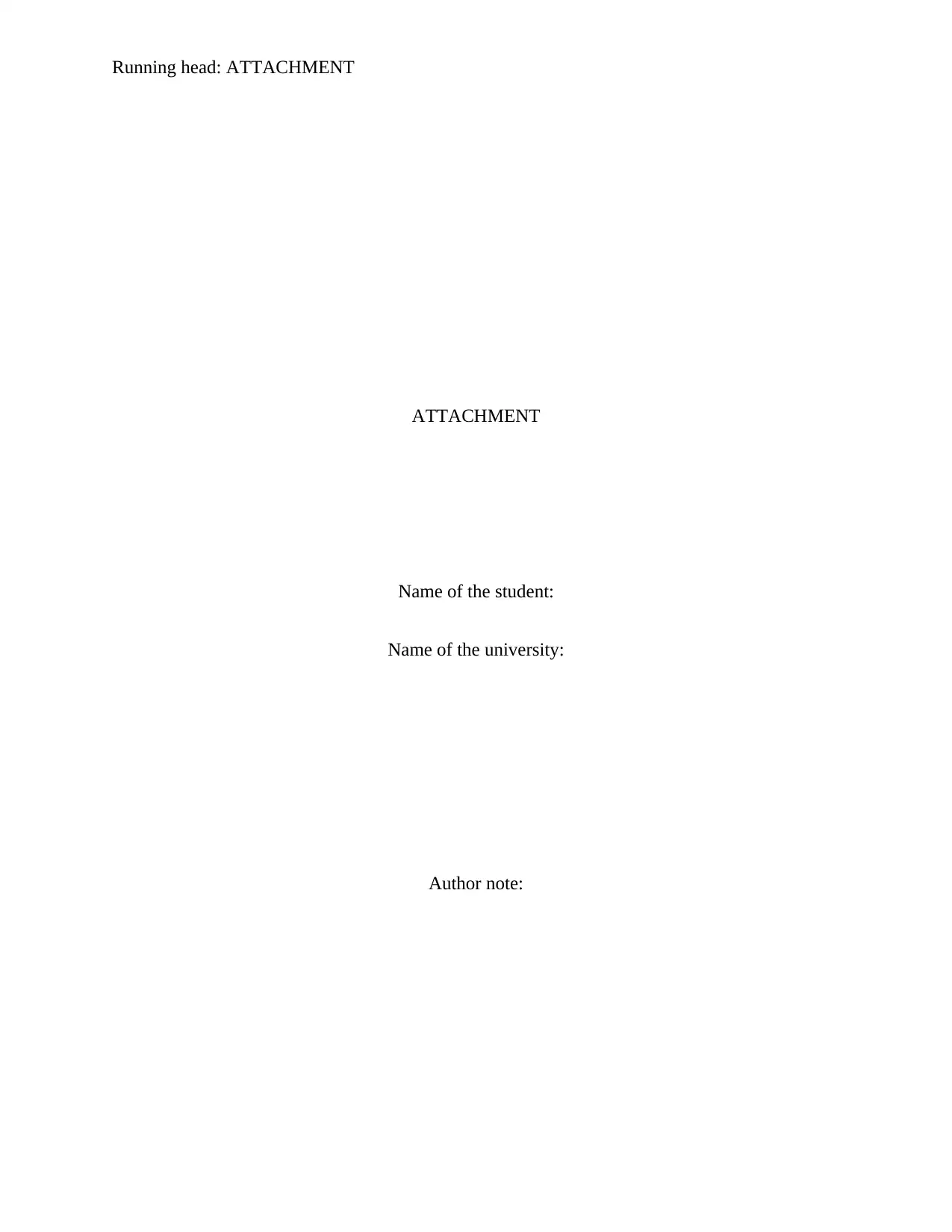
Running head: ATTACHMENT
ATTACHMENT
Name of the student:
Name of the university:
Author note:
ATTACHMENT
Name of the student:
Name of the university:
Author note:
Paraphrase This Document
Need a fresh take? Get an instant paraphrase of this document with our AI Paraphraser
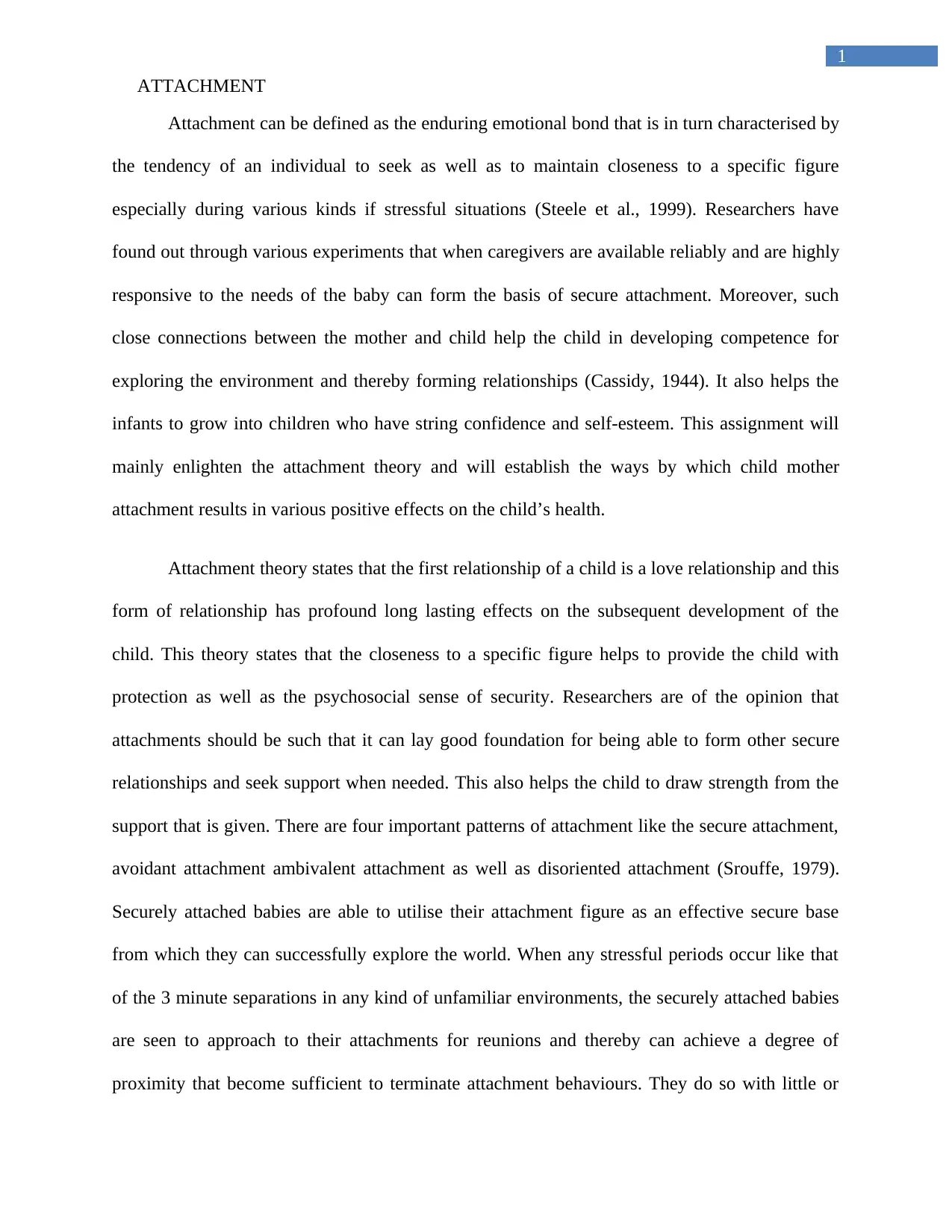
1
ATTACHMENT
Attachment can be defined as the enduring emotional bond that is in turn characterised by
the tendency of an individual to seek as well as to maintain closeness to a specific figure
especially during various kinds if stressful situations (Steele et al., 1999). Researchers have
found out through various experiments that when caregivers are available reliably and are highly
responsive to the needs of the baby can form the basis of secure attachment. Moreover, such
close connections between the mother and child help the child in developing competence for
exploring the environment and thereby forming relationships (Cassidy, 1944). It also helps the
infants to grow into children who have string confidence and self-esteem. This assignment will
mainly enlighten the attachment theory and will establish the ways by which child mother
attachment results in various positive effects on the child’s health.
Attachment theory states that the first relationship of a child is a love relationship and this
form of relationship has profound long lasting effects on the subsequent development of the
child. This theory states that the closeness to a specific figure helps to provide the child with
protection as well as the psychosocial sense of security. Researchers are of the opinion that
attachments should be such that it can lay good foundation for being able to form other secure
relationships and seek support when needed. This also helps the child to draw strength from the
support that is given. There are four important patterns of attachment like the secure attachment,
avoidant attachment ambivalent attachment as well as disoriented attachment (Srouffe, 1979).
Securely attached babies are able to utilise their attachment figure as an effective secure base
from which they can successfully explore the world. When any stressful periods occur like that
of the 3 minute separations in any kind of unfamiliar environments, the securely attached babies
are seen to approach to their attachments for reunions and thereby can achieve a degree of
proximity that become sufficient to terminate attachment behaviours. They do so with little or
ATTACHMENT
Attachment can be defined as the enduring emotional bond that is in turn characterised by
the tendency of an individual to seek as well as to maintain closeness to a specific figure
especially during various kinds if stressful situations (Steele et al., 1999). Researchers have
found out through various experiments that when caregivers are available reliably and are highly
responsive to the needs of the baby can form the basis of secure attachment. Moreover, such
close connections between the mother and child help the child in developing competence for
exploring the environment and thereby forming relationships (Cassidy, 1944). It also helps the
infants to grow into children who have string confidence and self-esteem. This assignment will
mainly enlighten the attachment theory and will establish the ways by which child mother
attachment results in various positive effects on the child’s health.
Attachment theory states that the first relationship of a child is a love relationship and this
form of relationship has profound long lasting effects on the subsequent development of the
child. This theory states that the closeness to a specific figure helps to provide the child with
protection as well as the psychosocial sense of security. Researchers are of the opinion that
attachments should be such that it can lay good foundation for being able to form other secure
relationships and seek support when needed. This also helps the child to draw strength from the
support that is given. There are four important patterns of attachment like the secure attachment,
avoidant attachment ambivalent attachment as well as disoriented attachment (Srouffe, 1979).
Securely attached babies are able to utilise their attachment figure as an effective secure base
from which they can successfully explore the world. When any stressful periods occur like that
of the 3 minute separations in any kind of unfamiliar environments, the securely attached babies
are seen to approach to their attachments for reunions and thereby can achieve a degree of
proximity that become sufficient to terminate attachment behaviours. They do so with little or
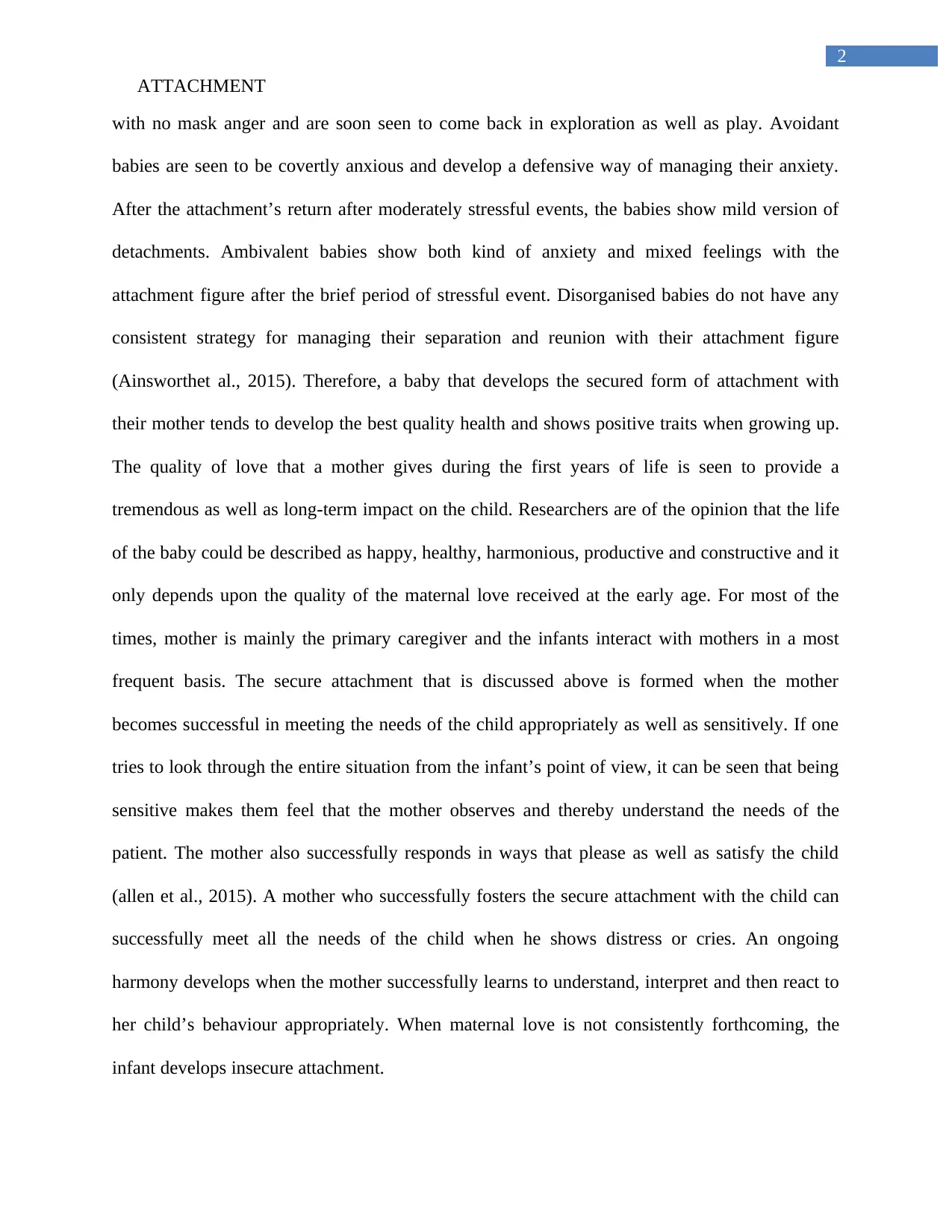
2
ATTACHMENT
with no mask anger and are soon seen to come back in exploration as well as play. Avoidant
babies are seen to be covertly anxious and develop a defensive way of managing their anxiety.
After the attachment’s return after moderately stressful events, the babies show mild version of
detachments. Ambivalent babies show both kind of anxiety and mixed feelings with the
attachment figure after the brief period of stressful event. Disorganised babies do not have any
consistent strategy for managing their separation and reunion with their attachment figure
(Ainsworthet al., 2015). Therefore, a baby that develops the secured form of attachment with
their mother tends to develop the best quality health and shows positive traits when growing up.
The quality of love that a mother gives during the first years of life is seen to provide a
tremendous as well as long-term impact on the child. Researchers are of the opinion that the life
of the baby could be described as happy, healthy, harmonious, productive and constructive and it
only depends upon the quality of the maternal love received at the early age. For most of the
times, mother is mainly the primary caregiver and the infants interact with mothers in a most
frequent basis. The secure attachment that is discussed above is formed when the mother
becomes successful in meeting the needs of the child appropriately as well as sensitively. If one
tries to look through the entire situation from the infant’s point of view, it can be seen that being
sensitive makes them feel that the mother observes and thereby understand the needs of the
patient. The mother also successfully responds in ways that please as well as satisfy the child
(allen et al., 2015). A mother who successfully fosters the secure attachment with the child can
successfully meet all the needs of the child when he shows distress or cries. An ongoing
harmony develops when the mother successfully learns to understand, interpret and then react to
her child’s behaviour appropriately. When maternal love is not consistently forthcoming, the
infant develops insecure attachment.
ATTACHMENT
with no mask anger and are soon seen to come back in exploration as well as play. Avoidant
babies are seen to be covertly anxious and develop a defensive way of managing their anxiety.
After the attachment’s return after moderately stressful events, the babies show mild version of
detachments. Ambivalent babies show both kind of anxiety and mixed feelings with the
attachment figure after the brief period of stressful event. Disorganised babies do not have any
consistent strategy for managing their separation and reunion with their attachment figure
(Ainsworthet al., 2015). Therefore, a baby that develops the secured form of attachment with
their mother tends to develop the best quality health and shows positive traits when growing up.
The quality of love that a mother gives during the first years of life is seen to provide a
tremendous as well as long-term impact on the child. Researchers are of the opinion that the life
of the baby could be described as happy, healthy, harmonious, productive and constructive and it
only depends upon the quality of the maternal love received at the early age. For most of the
times, mother is mainly the primary caregiver and the infants interact with mothers in a most
frequent basis. The secure attachment that is discussed above is formed when the mother
becomes successful in meeting the needs of the child appropriately as well as sensitively. If one
tries to look through the entire situation from the infant’s point of view, it can be seen that being
sensitive makes them feel that the mother observes and thereby understand the needs of the
patient. The mother also successfully responds in ways that please as well as satisfy the child
(allen et al., 2015). A mother who successfully fosters the secure attachment with the child can
successfully meet all the needs of the child when he shows distress or cries. An ongoing
harmony develops when the mother successfully learns to understand, interpret and then react to
her child’s behaviour appropriately. When maternal love is not consistently forthcoming, the
infant develops insecure attachment.
⊘ This is a preview!⊘
Do you want full access?
Subscribe today to unlock all pages.

Trusted by 1+ million students worldwide
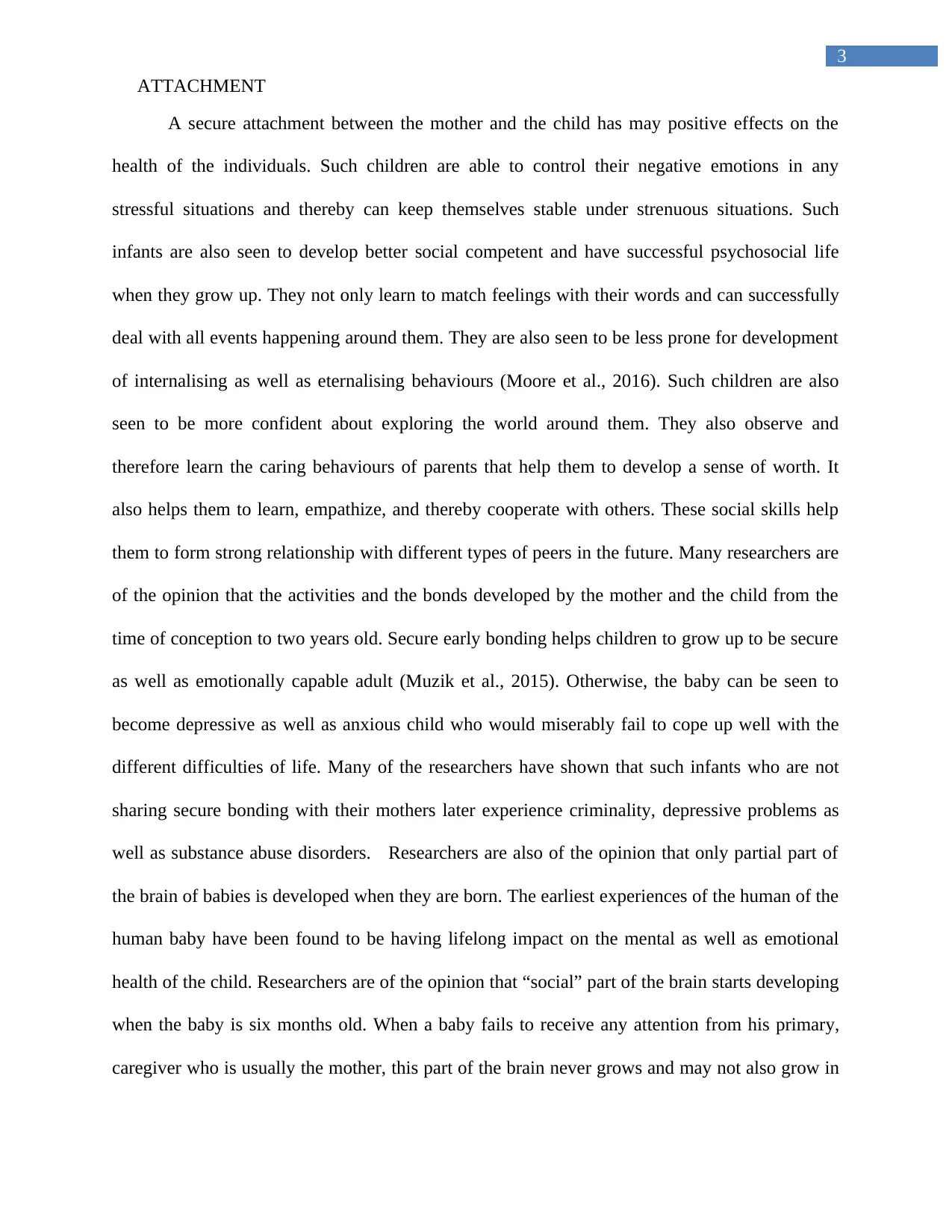
3
ATTACHMENT
A secure attachment between the mother and the child has may positive effects on the
health of the individuals. Such children are able to control their negative emotions in any
stressful situations and thereby can keep themselves stable under strenuous situations. Such
infants are also seen to develop better social competent and have successful psychosocial life
when they grow up. They not only learn to match feelings with their words and can successfully
deal with all events happening around them. They are also seen to be less prone for development
of internalising as well as eternalising behaviours (Moore et al., 2016). Such children are also
seen to be more confident about exploring the world around them. They also observe and
therefore learn the caring behaviours of parents that help them to develop a sense of worth. It
also helps them to learn, empathize, and thereby cooperate with others. These social skills help
them to form strong relationship with different types of peers in the future. Many researchers are
of the opinion that the activities and the bonds developed by the mother and the child from the
time of conception to two years old. Secure early bonding helps children to grow up to be secure
as well as emotionally capable adult (Muzik et al., 2015). Otherwise, the baby can be seen to
become depressive as well as anxious child who would miserably fail to cope up well with the
different difficulties of life. Many of the researchers have shown that such infants who are not
sharing secure bonding with their mothers later experience criminality, depressive problems as
well as substance abuse disorders. Researchers are also of the opinion that only partial part of
the brain of babies is developed when they are born. The earliest experiences of the human of the
human baby have been found to be having lifelong impact on the mental as well as emotional
health of the child. Researchers are of the opinion that “social” part of the brain starts developing
when the baby is six months old. When a baby fails to receive any attention from his primary,
caregiver who is usually the mother, this part of the brain never grows and may not also grow in
ATTACHMENT
A secure attachment between the mother and the child has may positive effects on the
health of the individuals. Such children are able to control their negative emotions in any
stressful situations and thereby can keep themselves stable under strenuous situations. Such
infants are also seen to develop better social competent and have successful psychosocial life
when they grow up. They not only learn to match feelings with their words and can successfully
deal with all events happening around them. They are also seen to be less prone for development
of internalising as well as eternalising behaviours (Moore et al., 2016). Such children are also
seen to be more confident about exploring the world around them. They also observe and
therefore learn the caring behaviours of parents that help them to develop a sense of worth. It
also helps them to learn, empathize, and thereby cooperate with others. These social skills help
them to form strong relationship with different types of peers in the future. Many researchers are
of the opinion that the activities and the bonds developed by the mother and the child from the
time of conception to two years old. Secure early bonding helps children to grow up to be secure
as well as emotionally capable adult (Muzik et al., 2015). Otherwise, the baby can be seen to
become depressive as well as anxious child who would miserably fail to cope up well with the
different difficulties of life. Many of the researchers have shown that such infants who are not
sharing secure bonding with their mothers later experience criminality, depressive problems as
well as substance abuse disorders. Researchers are also of the opinion that only partial part of
the brain of babies is developed when they are born. The earliest experiences of the human of the
human baby have been found to be having lifelong impact on the mental as well as emotional
health of the child. Researchers are of the opinion that “social” part of the brain starts developing
when the baby is six months old. When a baby fails to receive any attention from his primary,
caregiver who is usually the mother, this part of the brain never grows and may not also grow in
Paraphrase This Document
Need a fresh take? Get an instant paraphrase of this document with our AI Paraphraser
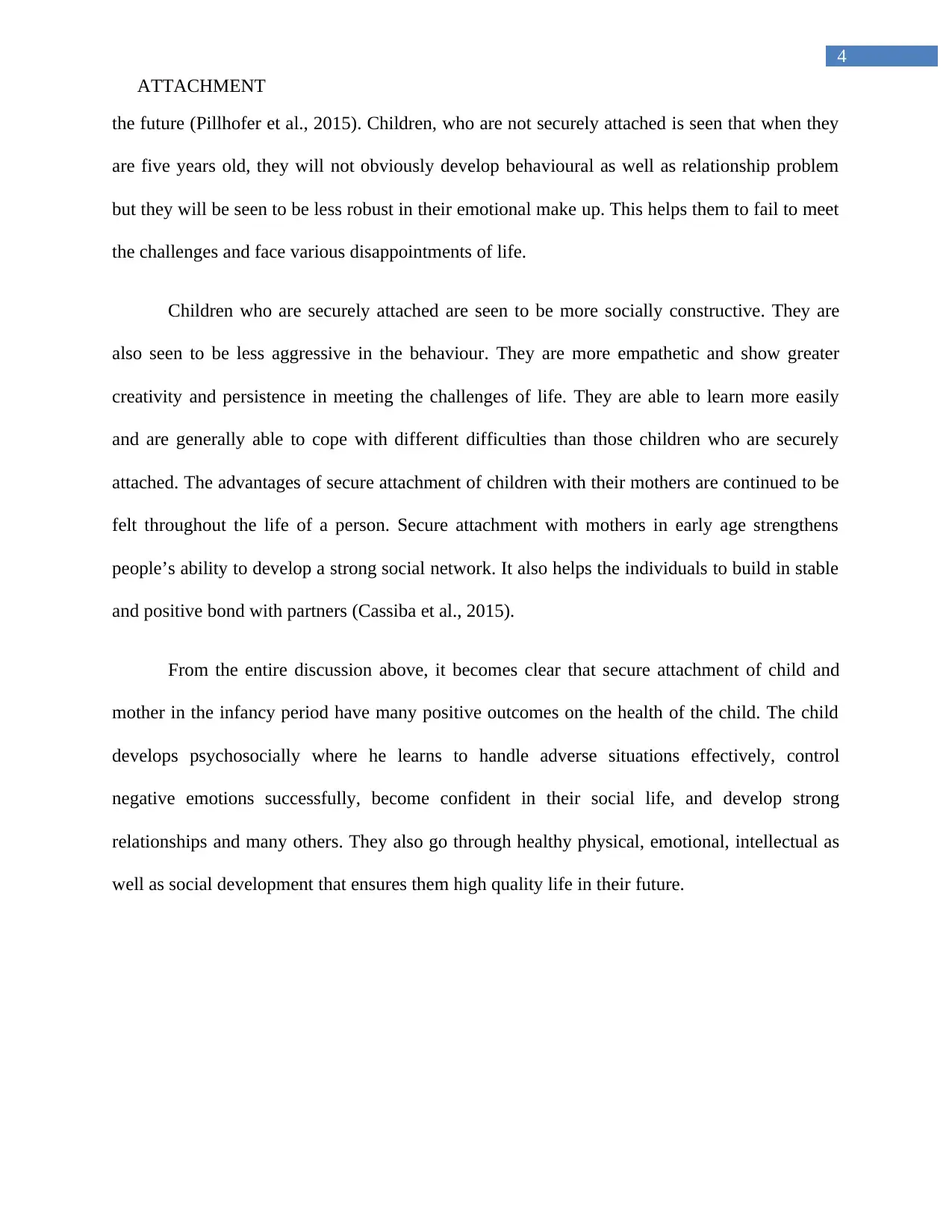
4
ATTACHMENT
the future (Pillhofer et al., 2015). Children, who are not securely attached is seen that when they
are five years old, they will not obviously develop behavioural as well as relationship problem
but they will be seen to be less robust in their emotional make up. This helps them to fail to meet
the challenges and face various disappointments of life.
Children who are securely attached are seen to be more socially constructive. They are
also seen to be less aggressive in the behaviour. They are more empathetic and show greater
creativity and persistence in meeting the challenges of life. They are able to learn more easily
and are generally able to cope with different difficulties than those children who are securely
attached. The advantages of secure attachment of children with their mothers are continued to be
felt throughout the life of a person. Secure attachment with mothers in early age strengthens
people’s ability to develop a strong social network. It also helps the individuals to build in stable
and positive bond with partners (Cassiba et al., 2015).
From the entire discussion above, it becomes clear that secure attachment of child and
mother in the infancy period have many positive outcomes on the health of the child. The child
develops psychosocially where he learns to handle adverse situations effectively, control
negative emotions successfully, become confident in their social life, and develop strong
relationships and many others. They also go through healthy physical, emotional, intellectual as
well as social development that ensures them high quality life in their future.
ATTACHMENT
the future (Pillhofer et al., 2015). Children, who are not securely attached is seen that when they
are five years old, they will not obviously develop behavioural as well as relationship problem
but they will be seen to be less robust in their emotional make up. This helps them to fail to meet
the challenges and face various disappointments of life.
Children who are securely attached are seen to be more socially constructive. They are
also seen to be less aggressive in the behaviour. They are more empathetic and show greater
creativity and persistence in meeting the challenges of life. They are able to learn more easily
and are generally able to cope with different difficulties than those children who are securely
attached. The advantages of secure attachment of children with their mothers are continued to be
felt throughout the life of a person. Secure attachment with mothers in early age strengthens
people’s ability to develop a strong social network. It also helps the individuals to build in stable
and positive bond with partners (Cassiba et al., 2015).
From the entire discussion above, it becomes clear that secure attachment of child and
mother in the infancy period have many positive outcomes on the health of the child. The child
develops psychosocially where he learns to handle adverse situations effectively, control
negative emotions successfully, become confident in their social life, and develop strong
relationships and many others. They also go through healthy physical, emotional, intellectual as
well as social development that ensures them high quality life in their future.
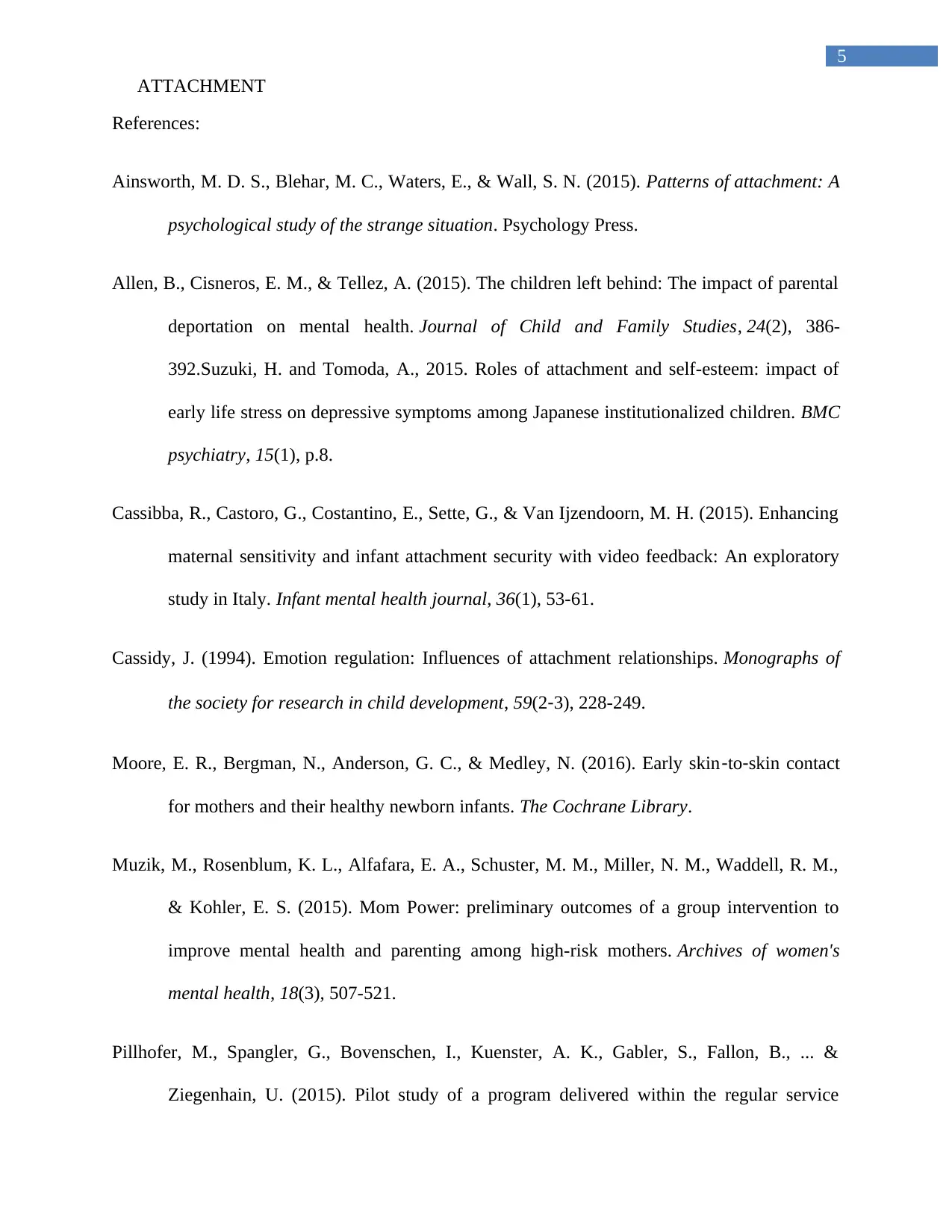
5
ATTACHMENT
References:
Ainsworth, M. D. S., Blehar, M. C., Waters, E., & Wall, S. N. (2015). Patterns of attachment: A
psychological study of the strange situation. Psychology Press.
Allen, B., Cisneros, E. M., & Tellez, A. (2015). The children left behind: The impact of parental
deportation on mental health. Journal of Child and Family Studies, 24(2), 386-
392.Suzuki, H. and Tomoda, A., 2015. Roles of attachment and self-esteem: impact of
early life stress on depressive symptoms among Japanese institutionalized children. BMC
psychiatry, 15(1), p.8.
Cassibba, R., Castoro, G., Costantino, E., Sette, G., & Van Ijzendoorn, M. H. (2015). Enhancing
maternal sensitivity and infant attachment security with video feedback: An exploratory
study in Italy. Infant mental health journal, 36(1), 53-61.
Cassidy, J. (1994). Emotion regulation: Influences of attachment relationships. Monographs of
the society for research in child development, 59(2‐3), 228-249.
Moore, E. R., Bergman, N., Anderson, G. C., & Medley, N. (2016). Early skin‐to‐skin contact
for mothers and their healthy newborn infants. The Cochrane Library.
Muzik, M., Rosenblum, K. L., Alfafara, E. A., Schuster, M. M., Miller, N. M., Waddell, R. M.,
& Kohler, E. S. (2015). Mom Power: preliminary outcomes of a group intervention to
improve mental health and parenting among high-risk mothers. Archives of women's
mental health, 18(3), 507-521.
Pillhofer, M., Spangler, G., Bovenschen, I., Kuenster, A. K., Gabler, S., Fallon, B., ... &
Ziegenhain, U. (2015). Pilot study of a program delivered within the regular service
ATTACHMENT
References:
Ainsworth, M. D. S., Blehar, M. C., Waters, E., & Wall, S. N. (2015). Patterns of attachment: A
psychological study of the strange situation. Psychology Press.
Allen, B., Cisneros, E. M., & Tellez, A. (2015). The children left behind: The impact of parental
deportation on mental health. Journal of Child and Family Studies, 24(2), 386-
392.Suzuki, H. and Tomoda, A., 2015. Roles of attachment and self-esteem: impact of
early life stress on depressive symptoms among Japanese institutionalized children. BMC
psychiatry, 15(1), p.8.
Cassibba, R., Castoro, G., Costantino, E., Sette, G., & Van Ijzendoorn, M. H. (2015). Enhancing
maternal sensitivity and infant attachment security with video feedback: An exploratory
study in Italy. Infant mental health journal, 36(1), 53-61.
Cassidy, J. (1994). Emotion regulation: Influences of attachment relationships. Monographs of
the society for research in child development, 59(2‐3), 228-249.
Moore, E. R., Bergman, N., Anderson, G. C., & Medley, N. (2016). Early skin‐to‐skin contact
for mothers and their healthy newborn infants. The Cochrane Library.
Muzik, M., Rosenblum, K. L., Alfafara, E. A., Schuster, M. M., Miller, N. M., Waddell, R. M.,
& Kohler, E. S. (2015). Mom Power: preliminary outcomes of a group intervention to
improve mental health and parenting among high-risk mothers. Archives of women's
mental health, 18(3), 507-521.
Pillhofer, M., Spangler, G., Bovenschen, I., Kuenster, A. K., Gabler, S., Fallon, B., ... &
Ziegenhain, U. (2015). Pilot study of a program delivered within the regular service
⊘ This is a preview!⊘
Do you want full access?
Subscribe today to unlock all pages.

Trusted by 1+ million students worldwide
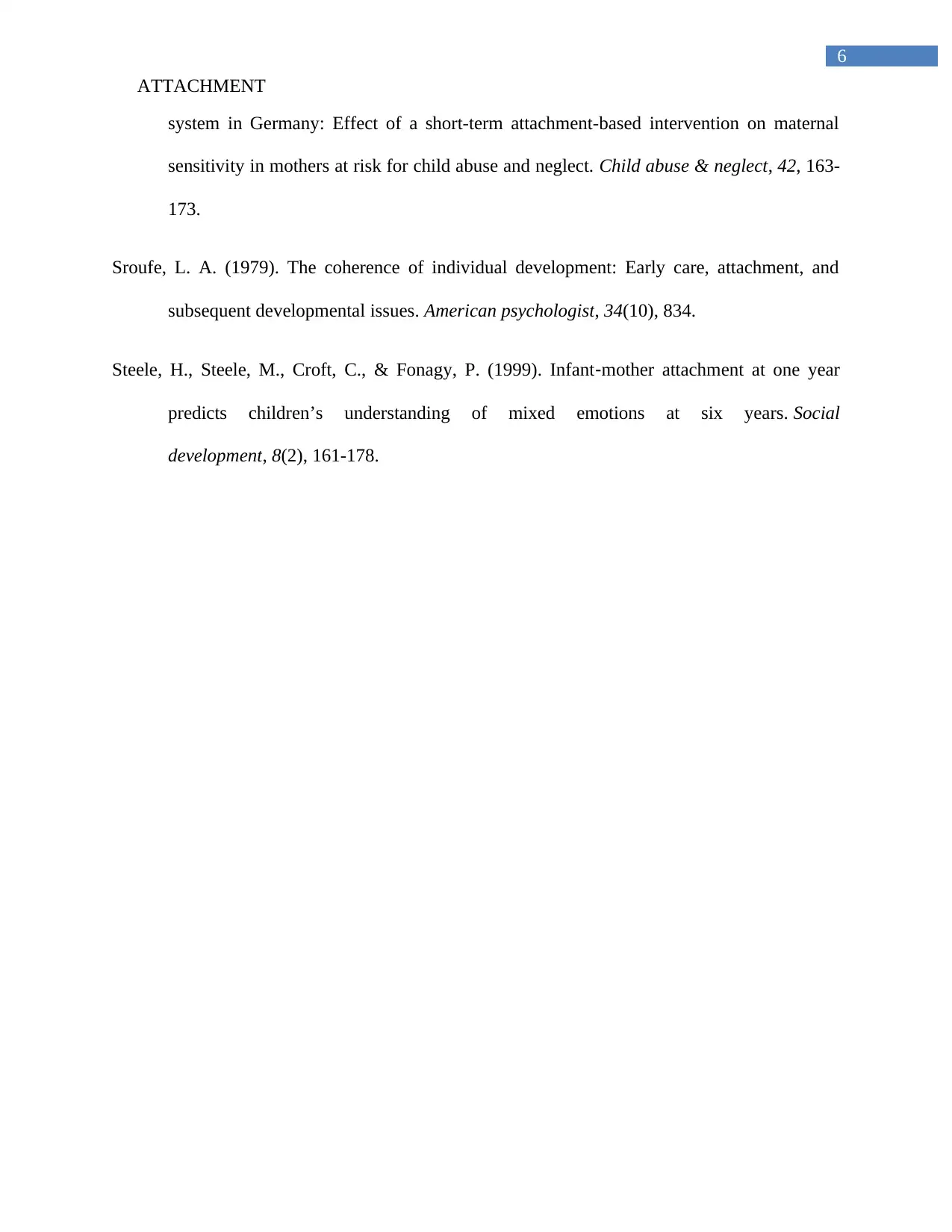
6
ATTACHMENT
system in Germany: Effect of a short-term attachment-based intervention on maternal
sensitivity in mothers at risk for child abuse and neglect. Child abuse & neglect, 42, 163-
173.
Sroufe, L. A. (1979). The coherence of individual development: Early care, attachment, and
subsequent developmental issues. American psychologist, 34(10), 834.
Steele, H., Steele, M., Croft, C., & Fonagy, P. (1999). Infant‐mother attachment at one year
predicts children’s understanding of mixed emotions at six years. Social
development, 8(2), 161-178.
ATTACHMENT
system in Germany: Effect of a short-term attachment-based intervention on maternal
sensitivity in mothers at risk for child abuse and neglect. Child abuse & neglect, 42, 163-
173.
Sroufe, L. A. (1979). The coherence of individual development: Early care, attachment, and
subsequent developmental issues. American psychologist, 34(10), 834.
Steele, H., Steele, M., Croft, C., & Fonagy, P. (1999). Infant‐mother attachment at one year
predicts children’s understanding of mixed emotions at six years. Social
development, 8(2), 161-178.
1 out of 7
Related Documents
Your All-in-One AI-Powered Toolkit for Academic Success.
+13062052269
info@desklib.com
Available 24*7 on WhatsApp / Email
![[object Object]](/_next/static/media/star-bottom.7253800d.svg)
Unlock your academic potential
Copyright © 2020–2025 A2Z Services. All Rights Reserved. Developed and managed by ZUCOL.





